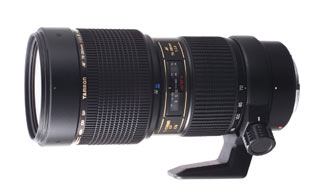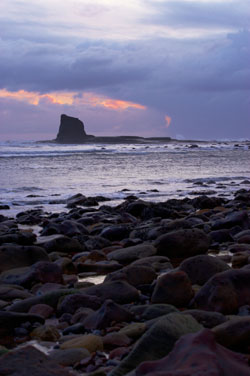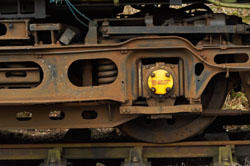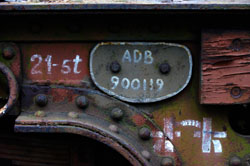Tamron SP AF70-200mm F/2.8 Di LD (IF) Macro
 |  Optical expert Gary Wolstenholme gets to grips with Tamron's high speed telezoom. |
This Tamron costs around £620, which is a very competitive price for a constant F/2.8 telezoom such as this. The bright maximum aperture lends itself to shooting fast action, in low light, or for isolating your subject by using a wide aperture for shallow depth of field. The only third party manufacturer offering a current equivalent is Sigma, and their 70-200mm is a little more expensive at around £660, but has a silent focus motor.
Manufacturer's own offerings in this focal range tend to be much more expensive, with the possible exception of Canon's 70-200mm F/4L, which cost only £529 for the non-image stabilised version. Of course this lens is a stop slower throughout the range. Canon's F/2.8 versions of this focal range cost £1015 for the non-image stabilised version and £2450 for the latest IS lens and £1500 for the older version. Nikon's 70-200mm F/2.8 includes Vibration Reduction and silent focusing and costs £1650, whilst Sony's 70-200mm G lens costs £1475.
Tamron SP AF70-200mm F/2.8 Di LD (IF) Macro: Handling and features
For a 70-200mm F/2.8, this lens feels quite lightweight, thanks in part to the materials used in the construction. Most of the exterior of the lens is made from injection moulded plastics, which have a high-quality finish to them and feel sturdy enough to take some heavy use.
The standard lens case is also worth a mention as it is one of those quick-change designs, that actually is actually useful in the field for both protecting the lens, and for wearing on a belt or shoulder strap as it allows quick access to the lens, whilst offering good protection against bumps, scrapes and the elements.
Focusing is performed internally so the lens does not extend, and the front filter ring does not rotate. The elements inside the lens which are moved during focusing are quite large, which creates a slight torque reaction as they are spun back and forth inside the lens at speed. This is not necessarily an issue as it is something any user will become used to in time. The focus motor used in this lens makes no claims to be silent, but isn't disturbingly noisy either. Focusing is reasonably quick in good light, but it will tend to hunt a little in lower light conditions.
 |
| Its fast aperture means that hand-holding even in poor light is possible. |
Switching between Automatic and Manual focus mode is made easy thanks to Tamron's push/pull focus switch. Pushing the focus ring forward switches to auto and disengages the focusing ring, so that it doesn't rotate during use and catch your fingers. Pulling it back towards you switches the lens to manual focus, exposing a blue ring around the front of the lens, so that you can easily check how you the lens set. The manual focus action is smooth and precise offering up just enough resistance.
Overall I feel that this lens handles very well for the price. It balances well on my Nikon D700, with or without the MB-D10 grip and the lighter weight makes it quite comfortable to hand-hold for extended periods.
Tamron SP AF70-200mm F/2.8 Di LD (IF) Macro: Performance
For this review, the lens was tested on a 12Mp Nikon D700 using Imatest. At 70mm this lens is a superb performer, producing images of very good to excellent resolution throughout at nearly all aperture settings. Wide open at F/2.8 the centre resolution is already very good and just about acceptable towards the edges of the frame. F/32 suffers a loss of resolution and contrast due to diffraction, but this is to be expected at such a small aperture. The best overall image quality is obtained at F/5.6 where the resolution is excellent from corner to corner.
By 135mm, the overall performance of this lens actually improves, with sharpness across the image area improving wide open at F/2.8. The best overall sharpness is still obtained at F/5.6, although the centre resolution peaks at F/4, which would make this lens perfect for portraiture at 135mm.
Unfortunately, the performance at wide apertures drops off a little a 200mm, with the lens really needing to be stopped down to achieve the best quality. The optimum aperture for sharpness has fallen to F/11, although many will find the results more than acceptable from F/4 onwards.
Resolution at 70mm

Resolution at 135mm

Resolution at 200mm

Chromatic aberrations are really well controlled at shorter focal lengths. At 70mm colour fringes cover under half a pixel-width, which will be barely noticeable in most situations. Just as with the resolution, the control over fringing improves towards 135mm then deteriorates again towards 200mm. Even at its worst, the aberrations only cover an area of 0.6 pixel-widths at 200mm and f/11, which will be very difficult to detect unless you purposefully go looking for it.
Light falloff in the corners is typical for a wide aperture zoom such as this. At 70mm and F/2.8 the corners are 1.14 stops darker than the image centre and at 200mm the corners are 0.93 stops darker. At all focal lengths, stopping down to F/5.6 seems to virtually eliminate any signs of vignetting.
 |  |
 |  |
| This Tamron telezoom is not a true macro lens, but its close focusing capabilities are pretty impressive nonetheless and image quality is excellent. | |
Distortion at 70mm is well enough controlled to rarely be an issue, with Imatest recording only 0.615% barrel distortion. By 200mm the barrelling has been traded for pincushion distortion, which is strong enough to be noticeable in some circumstances, but is by no means extreme. Imatest recoded pincushion distortion of 1.62% which can easily be corrected in image editing software should it become an issue. In most cases, it will not though.
A small amount of ghosting and flare can appear in images taken with strong sources of light in them. Light sources outside of the frame poses few problems, especially if the lens is used with the supplied hood, which does a sterling job of shielding the front element from extraneous light.
Tamron SP AF70-200mm F/2.8 Di LD (IF) Macro: Verdict
For the price, this lens represents excellent value for money, producing images with superb resolution at shorter focal lengths and good build quality, all in a relatively lightweight package.
Although the resolution does drop off at 200m, I feel it will still be good enough when stopped down to F/4 or below and as such will still please most people looking for wide aperture telephoto on a budget.
 Tamron SP AF70-200mm F/2.8 Di LD (IF) Macro: Pros
Tamron SP AF70-200mm F/2.8 Di LD (IF) Macro: Pros Good build quality
Good build quality Excellent resolution between 70mm and 135mm
Excellent resolution between 70mm and 135mm Good value for money
Good value for money Supplied lens case is an excellent design
Supplied lens case is an excellent designTamron SP AF70-200mm F/2.8 Di LD (IF) Macro: Cons
 Falloff in resolution at 200mm
Falloff in resolution at 200mm Torque reaction during focusing may be disturbing at first
Torque reaction during focusing may be disturbing at first| FEATURES |  |
| HANDLING |  |
| PERFORMANCE |  |
| VALUE |  |
| OVERALL |  |
Tamron SP AF70-200mm F/2.8 Di LD (IF) Macro: Lens specification
| Price: | £620 |
| Contact: | http://www.intro2020.co.uk/pages/tamron.htm |
| Filter size: | 77mm |
| Format: | Full frame |
| Construction: | 18 elements in 13 groups |
| Angle-of-view: | 34°21’ – 12°21’ |
| 35mm equivalent focal length (on APS-C body): | 105-300mm (Nikon, Sony, Pentax) 112-320mm (Canon) |
| Internal focusing: | Yes |
| Image stabilisation: | No |
| Minimum focus: | 95cm |
| Maximum aperture: | f/2.8 |
| Minimum aperture: | f/32 |
| Weight: | 1150g |
| Size (lxw): | 194.3mm x 89.5mm |
| In the box: | Lens Hood, Case |
The Tamron SP AF70-200mm F/2.8 Di LD (IF) Macro lens costs £620 and is available from Warehouse Express here:
Tamron SP AF70-200mm F/2.8 Di LD (IF) Macro - Nikon Fit
Tamron SP AF70-200mm F/2.8 Di LD (IF) Macro - Sony Fit
Add your message
Login required
Please login here or if you've not registered, you can register here. Registering is safe, quick and free.
Please login here or if you've not registered, you can register here. Registering is safe, quick and free.
photodo Stats
1102 lenses
428 MTF tests
74 in-depth photodo reviews
100+ users join each day
Help the lens community by reviewing or rating a lens today via our lens search
428 MTF tests
74 in-depth photodo reviews
100+ users join each day
Help the lens community by reviewing or rating a lens today via our lens search
Latest Lens Reviews
- Chinon 28mm f/2.8 Vintage Lens Review
- Canon EF 70-200mm f/4L IS II USM Lens Review
- Samyang AF 85mm f/1.4 EF Review
- Sigma 70mm f/2.8 DG Macro Art Review
- Samyang AF 24mm f/2.8 FE Review
- Meike 50mm f/1.7 Review
- Tamron 70-210mm f/4 Di VC USD Review
- Lensbaby Burnside 35mm f/2.8 Review
- Asahi Super Takumar 50mm f/1.4 Review
- Asahi Super-Multi-Coated Takumar 135mm f/3.5 Review
